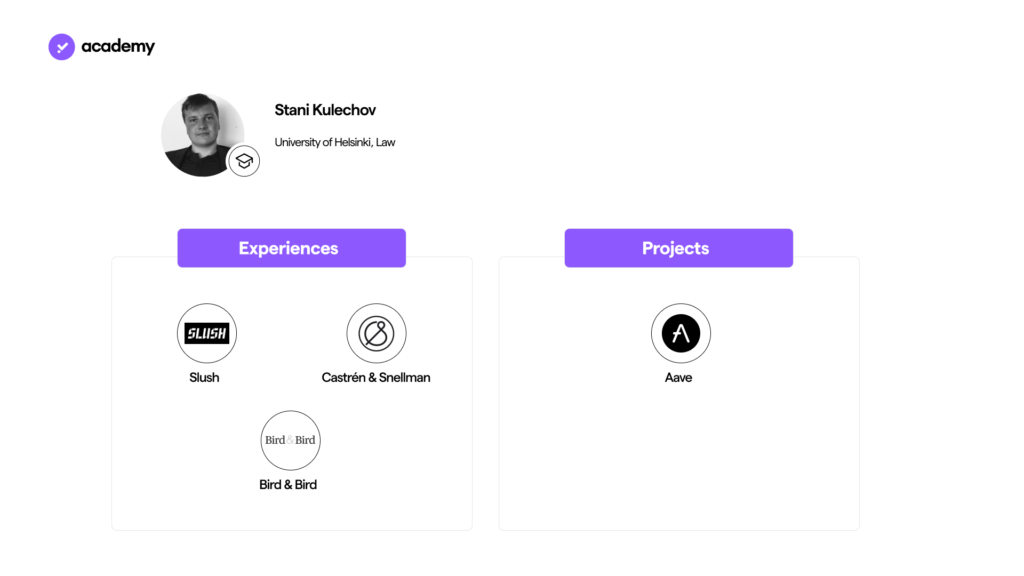Stani Kulechov and Aave: the finnish lawyer of DeFi
August 25, 2022
10 min

Stani Kulechov is the creator of the decentralised lending platform Aave, which started out as ETHLend. His path is by no means ordinary: he designed his idea in Finland, a country that does not stand out in the blockchain environment. He also has an unusual educational background compared to most crypto heroes. Nevertheless, his projects today are a hub in the DeFi ecosystem and challenge the authority of Twitter. Let’s find out how Aave and the social network Web3 Lens Protocol came about.
Who is Stani Kulechov: smart contracts from Finland
Stani Kulechov‘s origins are peculiar, at least when it comes to Crypto Heroes. He was born in Helsinki, Finland ‘not the place where you would expect a big project to come from’, Stani commented in this interview. However, looking at the environment in which he grew up, it is not so strange that he created Aave, a protocol for decentralised lending.
Stani, in fact, highlighted some of his small country’s strengths: Finland relies heavily on education and innovation, citing the thriving gaming industry (Angry Birds, Clash of Clans), Nokia‘s success, and the Linux operating system as proof of this. Hinting at the open-source nature of Linux , Stani said that building in DeFi‘s permissionless, open and collaborative ecosystem is what really allowed his project to come to life. Given the free access to codes, the next big thing could come from an even smaller country and ‘maybe that’s the point of decentralised finance’.
Taking a step back, let’s take a closer look at who Stani Kulechov is: still outside the norm, he is not a software engineer or programming expert. In 2020, he graduated with a Master’s degree in Law from the University of Helsinki. Before his studies, however, he gained experience in web development, focusing mainly on financial applications. He developed a simple app to credit rewards generated by app stores on a daily basis, which would usually take 15 days. Also in the interview mentioned above, Stani says that he was born ‘always somehow … close to software, my brother used to basically tweak linux kernels’.
Kernel
A kernel programme is the core of a computer’s operating system, it allows hardware resources to interact with the software component, acting as an intermediary. It is hosted in RAM memory from start-up to system shutdown.
Stani Kulechov also never thought of actually working as a lawyer, despite his experiences as an apprentice at Castrén & Snellman and Bird & Bird in 2017. Rather, it was the intersection of programming and law that got him hooked. Looking for a way to automate legal agreements, he discovered Ethereum and smart contracts, the technology to bring law and the digital world together. So after weeks of study, Kulechov began to imagine what he could actually build with smart contracts: ‘when I understood smart contracts and the power of having immutable code, then it suddenly clicked to me: once you deploy the code and, in a way, it’s immutable, you don’t need the trust and you can even get rid of the lawyers.’
This enlightenment convinced Stani to develop a platform for decentralised loans, linking lenders and borrowers in a peer-to-peer manner. What resulted was the proof-of-concept of ETHLend, the precursor of Aave. Let’s find out about the events that marked the launch of the protocol, analysing a few steps in the history of Ethereum, even before the impressive volumes of DeFi protocols arrived: what is the story behind Aave’s creation?
Fun fact
Stani Kulechov volunteered for SLUSH in 2016, the Tech event held annually in Helsinki to gather startups and investors from around the world. A few years later, in 2021, Stani attended the conference again, but as a founder this time, presenting the Aave project.
From ETHLend to Aave: constant innovation
In 2016 Stani Kulechov began to observe the nascent Ethereum ecosystem: a very different environment from the one we know today, still participated in by few users and populated at most by a few prototypes of today’s DeFi services. This was the context in which Stani experienced the hack of the DAO project: the first example of a decentralised autonomous organisation, from which 3.6 million ETH were stolen. Stani, however, did not let the hostile conditions get him down: ‘[as a result of the DAO hack], a lot of people kind of turned their backs and thought the experiment was a bit of failure to some extent, but for me it wasn’t ever an issue. I mean, I wanted to still build something related to finance and and then I kind of… started to think what that could be’
Thus the idea of ETHLend was born, to support decentralised loans between anonymous wallet addresses. One key component was however still missing: the borrowers had to be somehow incentivised to repay the loan. Further exploring the solutions already present on the Ethereum blockchain, Stani found EtherDelta, perhaps the first example of a decentralised exchange (DEX), from which Hayden Adams also took his cue to create Uniswap.
Initially, the EtherDelta protocol hosted very low volumes: there was effectively nothing to exchange yet and the use case was further hampered by a non-user-friendly design. ERC-20 tokens, however, soon added liquidity to the DEX and provided Stani with the incentive he was looking for: ‘the tokens could be used as collateral, released only when the borrower repaid the loan. This was the first concept of over-collateralised lending and we called the project ETHLend, short for Ethereum Lending’. Therefore, in 2017, ETHLend was created, but Stani did not immediately realise its potential: ‘I didn’t realise when the project could become big, I thought it was a good proof-of-concept, but I would probably forget about it’.

The first version of the lending service was presented as a peer-to-peer model. a measure to allow people to decide for themselves the risk level of the loan. Initially, each loan agreement was contained in a different smart contract: a process that soon became expensive, as it required the recurring payment of gas fees. Thus, ETHLend replaced p2p with peer-to-contract, essentially making lenders and borrowers interact with smart contracts and no longer directly with each other: the first step in the transformation to Aave.
Before being launched, Stani Kulechov’s protocol also faced other challenges. It was difficult to raise funds for ETHLend, until an ICO was organised in November 2017: 1 billion LENDs were sold for around $18 million. In retrospect, Stani stated that ‘if this type of funding had not existed, [Aave] would not be there, I mean no way’. Soon after, the bear market of 2018 reduced the price of ETH by 95 percent, but for Stani ‘the thesis has always been innovation, we didn’t care about the markets […] I only bought Ether to pay for gas for smart contracts and transactions, I never needed it as an investment’.
Stani Kulechov’s resilience carried Aave all the way to implementation on the Ethereum mainnet in 2020, the subsequent migration of the LEND code into the AAVE token, and finally the release of Version 2 of the protocol on the 3rd of December of the same year.
Morale and community support have always been important to Stani Kulechov. In fact he recounts that, during the crypto winter of 2018, the main difficulty was not the price collapse, but the lack of user enthusiasm, something that was ‘sad, at least for me’. Aave’s community has however always been diverse and some of the members, who currently support the project, go right back to the ETHLend era: ‘it’s fascinating because they saw our first products and, looking at where we are now, […] it feels like they’ve been on a journey,’ Stani commented, now happy. The importance of the community is also reflected in the governance capabilities, granted to AAVE holders since version V2.
Lens Protocol: Aave’s Twitter
Stani Kulechov is very active on his Twitter profile where, in July 2021, he replied to Jack Dorsey, who had announced he would create an open-source platform for Bitcoin-based services (very similar to Aave in functionality). He claimed that that Aave would instead build ‘Twitter on Ethereum’.
A tweet with an air of defiance, but considered ironic by most, especially following another tweet, which actually cost Stani dearly. In fact, in the climate of uncertainty generated by the possible purchase of Twitter by Elon Musk, he jokingly stated that he would serve as interim CEO pending the handover, but was immediately banned from the platform itself. A few hours later, he came back online, but commented on the incident by stressing the danger of centralised control of content, an intolerable form of censorship. An especially valid point considering the equal and decentralised nature of Web 3, represented by the Aave project itself.
In spite of everything, Stani has not lost his sarcastic streak, but has indeed fulfilled his commitment to build an ‘Aave version’ of Twitter, the Lens Protocol. A Web 3 social network, based on owning and monetising one’s own content, certified by ‘NFT profiles’ and other types of non-fungible tokens; where the community has continued to build in the Lens ‘garden’.
The Lens Protocol is another idea of Stani Kulechov, who shared his view with us: ‘As we have ownership of […] financial protocols and communities and creators, what if we actually can have ownership of our own presence in social media — our profiles, our social identities? “. This protocol, born almost as a challenge, will have to prove the value of decentralisation to compete with the authority of Twitter, but one thing is certain: now that you know who Stani Kulechov is, you will have realised that he is not to be trifled with.


